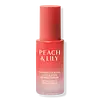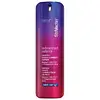What's inside
What's inside
 Key Ingredients
Key Ingredients

 Benefits
Benefits

 Concerns
Concerns

 Ingredients Side-by-side
Ingredients Side-by-side

Water
Skin ConditioningLactic Acid
BufferingTromethamine
Buffering1,2-Hexanediol
Skin ConditioningCaprylic/Capric Triglyceride
MaskingCetearyl Olivate
Sorbitan Olivate
EmulsifyingGlycerin
HumectantHydrogenated Polydecene
EmollientJania Rubens Extract
Skin ConditioningPanax Ginseng Root Extract
EmollientCeramide NP
Skin ConditioningCamellia Japonica Flower Extract
EmollientCamellia Sinensis Leaf Extract
AntimicrobialSaccharomyces/Viscum Album Ferment Extract
Skin ConditioningLactobacillus/Soybean Ferment Extract
Skin ConditioningSaccharomyces/Imperata Cylindrica Root Ferment Extract
EmollientSaccharomyces/Rice Ferment Filtrate
Skin ConditioningButylene Glycol
HumectantXylitol
HumectantPolyglutamic Acid
Skin ConditioningHyaluronic Acid
HumectantHydrolyzed Sodium Hyaluronate
Skin ConditioningHydrolyzed Hyaluronic Acid
HumectantSodium Hyaluronate
HumectantSodium Hyaluronate Crosspolymer
HumectantGinkgo Biloba Leaf Extract
Skin ConditioningPhellinus Linteus Extract
Skin ConditioningTremella Fuciformis Extract
HumectantMorus Alba Root Extract
BleachingPropanediol
SolventCaprylyl Glycol
EmollientAcetyl Hexapeptide-8
HumectantCopper Tripeptide-1
Skin ConditioningPalmitoyl Pentapeptide-4
Skin ConditioningOligopeptide-1
Skin ConditioningOligopeptide-2
Skin ConditioningAdenosine
Skin ConditioningSodium Polyacryloyldimethyl Taurate
Emulsion StabilisingPentylene Glycol
Skin ConditioningEthyl Hexanediol
SolventEthylhexylglycerin
Skin ConditioningWater, Lactic Acid, Tromethamine, 1,2-Hexanediol, Caprylic/Capric Triglyceride, Cetearyl Olivate, Sorbitan Olivate, Glycerin, Hydrogenated Polydecene, Jania Rubens Extract, Panax Ginseng Root Extract, Ceramide NP, Camellia Japonica Flower Extract, Camellia Sinensis Leaf Extract, Saccharomyces/Viscum Album Ferment Extract, Lactobacillus/Soybean Ferment Extract, Saccharomyces/Imperata Cylindrica Root Ferment Extract, Saccharomyces/Rice Ferment Filtrate, Butylene Glycol, Xylitol, Polyglutamic Acid, Hyaluronic Acid, Hydrolyzed Sodium Hyaluronate, Hydrolyzed Hyaluronic Acid, Sodium Hyaluronate, Sodium Hyaluronate Crosspolymer, Ginkgo Biloba Leaf Extract, Phellinus Linteus Extract, Tremella Fuciformis Extract, Morus Alba Root Extract, Propanediol, Caprylyl Glycol, Acetyl Hexapeptide-8, Copper Tripeptide-1, Palmitoyl Pentapeptide-4, Oligopeptide-1, Oligopeptide-2, Adenosine, Sodium Polyacryloyldimethyl Taurate, Pentylene Glycol, Ethyl Hexanediol, Ethylhexylglycerin
Water
Skin ConditioningTriheptanoin
Skin ConditioningPropanediol
SolventMyristyl Nicotinate
Skin ConditioningDicaprylyl Ether
EmollientCoconut Alkanes
EmollientSqualane
EmollientDimethicone
Emollient1,2-Hexanediol
Skin ConditioningEctoin
Skin ConditioningBis-Stearyl Dimethicone
EmollientRetinol
Skin ConditioningWithania Somnifera Root Extract
Skin ConditioningPolyglutamic Acid
Skin ConditioningMorus Alba Leaf Extract
Skin ConditioningOryza Sativa Bran Extract
Skin ConditioningRosmarinus Officinalis Leaf Extract
AntimicrobialSodium Hyaluronate
HumectantChondrus Crispus Extract
Skin ConditioningCarthamus Tinctorius Seed Oil
MaskingHelianthus Annuus Seed Oil
EmollientBacillus/Sea Salt Ferment Filtrate
Skin ConditioningHelianthus Annuus Extract
EmollientButyrospermum Parkii Butter
Skin ConditioningGlycerin
HumectantCucumis Sativus Seed Extract
Skin ConditioningBeta-Glucan
Skin ConditioningHordeum Vulgare Extract
EmollientBehenyl Alcohol
EmollientGlyceryl Behenate
EmollientBisabolol
MaskingLecithin
EmollientTocopheryl Acetate
AntioxidantZingiber Officinale Root Extract
MaskingPentylene Glycol
Skin ConditioningCaprylyl Glycol
EmollientPolysorbate 20
EmulsifyingPhytosterols
Skin ConditioningPolysilicone-11
Coco-Caprylate/Caprate
EmollientMethyl Methacrylate/Glycol Dimethacrylate Crosspolymer
Tocopherol
AntioxidantPolyisobutene
Caprylyl/Capryl Glucoside
CleansingAcrylates/C10-30 Alkyl Acrylate Crosspolymer
Emulsion StabilisingSynthetic Fluorphlogopite
Hydroxyacetophenone
AntioxidantSodium Acrylate/Sodium Acryloyldimethyl Taurate Copolymer
Emulsion StabilisingSorbitan Oleate
EmulsifyingXanthan Gum
EmulsifyingDisodium EDTA
Propyl Gallate
AntioxidantCaprylhydroxamic Acid
Aminomethyl Propanol
BufferingSilica
AbrasiveAscorbic Acid
AntioxidantParfum
MaskingBHT
AntioxidantCitric Acid
BufferingTin Oxide
AbrasiveAlpha-Isomethyl Ionone
PerfumingCI 77891
Cosmetic ColorantWater, Triheptanoin, Propanediol, Myristyl Nicotinate, Dicaprylyl Ether, Coconut Alkanes, Squalane, Dimethicone, 1,2-Hexanediol, Ectoin, Bis-Stearyl Dimethicone, Retinol, Withania Somnifera Root Extract, Polyglutamic Acid, Morus Alba Leaf Extract, Oryza Sativa Bran Extract, Rosmarinus Officinalis Leaf Extract, Sodium Hyaluronate, Chondrus Crispus Extract, Carthamus Tinctorius Seed Oil, Helianthus Annuus Seed Oil, Bacillus/Sea Salt Ferment Filtrate, Helianthus Annuus Extract, Butyrospermum Parkii Butter, Glycerin, Cucumis Sativus Seed Extract, Beta-Glucan, Hordeum Vulgare Extract, Behenyl Alcohol, Glyceryl Behenate, Bisabolol, Lecithin, Tocopheryl Acetate, Zingiber Officinale Root Extract, Pentylene Glycol, Caprylyl Glycol, Polysorbate 20, Phytosterols, Polysilicone-11, Coco-Caprylate/Caprate, Methyl Methacrylate/Glycol Dimethacrylate Crosspolymer, Tocopherol, Polyisobutene, Caprylyl/Capryl Glucoside, Acrylates/C10-30 Alkyl Acrylate Crosspolymer, Synthetic Fluorphlogopite, Hydroxyacetophenone, Sodium Acrylate/Sodium Acryloyldimethyl Taurate Copolymer, Sorbitan Oleate, Xanthan Gum, Disodium EDTA, Propyl Gallate, Caprylhydroxamic Acid, Aminomethyl Propanol, Silica, Ascorbic Acid, Parfum, BHT, Citric Acid, Tin Oxide, Alpha-Isomethyl Ionone, CI 77891
 Reviews
Reviews

Ingredients Explained
These ingredients are found in both products.
Ingredients higher up in an ingredient list are typically present in a larger amount.
1,2-Hexanediol is a synthetic liquid and another multi-functional powerhouse.
It is a:
- Humectant, drawing moisture into the skin
- Emollient, helping to soften skin
- Solvent, dispersing and stabilizing formulas
- Preservative booster, enhancing the antimicrobial activity of other preservatives
Caprylyl Glycol is a humectant and emollient, meaning it attracts and preserves moisture.
It is a common ingredient in many products, especially those designed to hydrate skin. The primary benefits are retaining moisture, skin softening, and promoting a healthy skin barrier.
Though Caprylyl Glycol is an alcohol derived from fatty acids, it is not the kind that can dry out skin.
This ingredient is also used as a preservative to extend the life of products. It has slight antimicrobial properties.
Learn more about Caprylyl GlycolGlycerin is already naturally found in your skin. It helps moisturize and protect your skin.
A study from 2016 found glycerin to be more effective as a humectant than AHAs and hyaluronic acid.
As a humectant, it helps the skin stay hydrated by pulling moisture to your skin. The low molecular weight of glycerin allows it to pull moisture into the deeper layers of your skin.
Hydrated skin improves your skin barrier; Your skin barrier helps protect against irritants and bacteria.
Glycerin has also been found to have antimicrobial and antiviral properties. Due to these properties, glycerin is often used in wound and burn treatments.
In cosmetics, glycerin is usually derived from plants such as soybean or palm. However, it can also be sourced from animals, such as tallow or animal fat.
This ingredient is organic, colorless, odorless, and non-toxic.
Glycerin is the name for this ingredient in American English. British English uses Glycerol/Glycerine.
Learn more about GlycerinPentylene glycol is typically used within a product to thicken it. It also adds a smooth, soft, and moisturizing feel to the product. It is naturally found in plants such as sugar beets.
The hydrophilic trait of Pentylene Glycol makes it a humectant. As a humectant, Pentylene Glycol helps draw moisture from the air to your skin. This can help keep your skin hydrated.
This property also makes Pentylene Glycol a great texture enhancer. It can also help thicken or stabilize a product.
Pentylene Glycol also acts as a mild preservative and helps to keep a product microbe-free.
Some people may experience mild eye and skin irritation from Pentylene Glycol. We always recommend speaking with a professional about using this ingredient in your routine.
Pentylene Glycol has a low molecular weight and is part of the 1,2-glycol family.
Learn more about Pentylene GlycolPolyglutamic Acid is made up many glutamic acids chained together. It is created from bacterial fermentation.
This ingredient is an effective skin hydrator and may help speed up wound healing. As a humectant, it draws and holds water to the skin. This ingredient is often compared to hyaluronic acid or glycerin. Similarly to hyaluronic acid, it can vary in molecular weights. This means polyglutamic acid is capable of bringing hydration to lower levels of the skin.
Fun fact: Polyglutamic Acid is found in the Japanese food, natto. It is also being used in cancer treatment studies.
Learn more about Polyglutamic AcidPropanediol is an all-star ingredient. It softens, hydrates, and smooths the skin.
It’s often used to:
Propanediol is not likely to cause sensitivity and considered safe to use. It is derived from corn or petroleum with a clear color and no scent.
Learn more about PropanediolSodium Hyaluronate is hyaluronic acid's salt form. It is commonly derived from the sodium salt of hyaluronic acid.
Like hyaluronic acid, it is great at holding water and acts as a humectant. This makes it a great skin hydrating ingredient.
Sodium Hyaluronate is naturally occurring in our bodies and is mostly found in eye fluid and joints.
These are some other common types of Hyaluronic Acid:
Learn more about Sodium HyaluronateWater. It's the most common cosmetic ingredient of all. You'll usually see it at the top of ingredient lists, meaning that it makes up the largest part of the product.
So why is it so popular? Water most often acts as a solvent - this means that it helps dissolve other ingredients into the formulation.
You'll also recognize water as that liquid we all need to stay alive. If you see this, drink a glass of water. Stay hydrated!
Learn more about Water